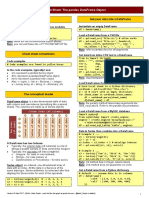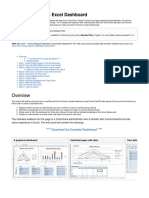Reshaping Data With Python
Uploaded by
Darlyn LCReshaping Data With Python
Uploaded by
Darlyn LCReshaping Data with > Working with indexes > Exploding and normalizing
pandas in Python # Move columns to the index with .set_index()
movies_indexed = movies.set_index("title")
# Expand list columns with .explode()
# Vectors inside the lists are given their own row
# The number of columns remains unchanged
music.explode("singles")
# Move index to columns with .reset_index()
movies_indexed.reset_index()
Learn Python online at www.DataCamp.com
# For dictionary columns, move items to their own columns with json_normalize()
# By default, each top-level key becomes a new column
# Replace index, left joining new index to existing data with .reindex()
pd.json_normalize(music_exploded["singles"])
avengers_index = ["The Avengers", "Avengers: Age of Ultron", "Avengers: Infinity War",
"Avengers: Endgame"]
> Content movies_indexed.reindex(avengers_index)
# Equivalent to pd.DataFrame(index=avengers_index) \
> Stacking and unstacking
# .merge(movies_indexed, how="left", left_index=True, right_index=True)
Definitions
# Move (multi-)indexes from a column index to a row index with .stack()
The majority of data analysis in Python is performed in pandas DataFrames. These are rectangular datasets consisting # level argument starts with 0 for the outer index
of rows and columns
An observation contains all the values or variables related to a single instance of the objects being analyzed. For
example, in a dataset of movies, each movie would be an observation.
> Joining and splitting columns pig_feed_stacked = pig_feed.stack(level=0)
A variable is an attribute for the object, across all the observations. For example, the release dates for all the movies
# Concatenate several columns into a single string column with .str.cat()
# Move (multi-)indexes from a row index to a column index with .stack()
Tidy data provides a standard way to organize data. Having a consistent shape for datasets enables you to worry less
# Each column must be converted to string type before joining
pig_feed_stacked.unstack(level=1)
about data structures and more on getting useful results. The principles of tidy data are
movies["release_year"].astype(str) \
Every column is a variable .str.cat(movies[["release_month", "release_day"]].astype(str), sep="-")
Every row is an observation
Every cell is a single value.
# Split a column on a delimiter into several columns with .str.split(expand=True)
> Converting to and from JSON
movies["directors"].str.split(",", expand=True)
import json
> Datasets used throughout this cheat sheet # Combine several columns into a list column with .values.tolist()
# Convert series containing nested elements to JSON string with json.dumps()
movies["release_list"] = movies[["release_year", "release_month", "release_day"]] \
json_singles = json.dumps(music["singles"].to_list())
Throughout this cheat sheet we will use a dataset of the top grossing movies of all time, stored as movies.
.values.tolist()
title release_year release_month release_day directors box_office_busd
# Add column from JSON string with with json.loads()
Avatar 2009 12 18 James Cameron 2.922
# Split a list column into separate columns with .to_list()
music["singles2"] = json.loads(json_singles)
Avengers: 2019 4 22 Anthony Russo,
2.798
Endgame Joe Russo movies[["release_year2", "release_month2", "release_day2"]] = \
Titanic 1997 11 01 James Cameron 2.202 movies["release_list"].to_list()
Star Wars Ep. 2015 12 14 J.J Abrams 2.068
VII: The Force
Awakens
> Dealing with missing data
Avengers:
Infinity War
2018 4 23 Anthony Russo,
Joe Russo
2.048
> Melting and pivoting # Drop rows containing any missing values in the specified columns with .dropna()
The second dataset involves an experiment with the number of unpopped kernels in bags of popcorn, adapted from the people.dropna(subset="weight_kg")
Popcorn dataset in the R's Stat2Data package. # Move side-by-side columns to consecutive rows with .melt()
popcorn.melt(id_vars="brand", var_name="trial", value_name = "n_unpopped")
brand trial_1 trial_2 trial_3 trial_4 trial_5 trial_6
# Fill missing values with a default value with .fillna()
Orville 26 35 18 14 8 6 people.fillna({"weight_kg": 100})
Seaway 47 47 14 34 21 37 # Melt using row index as id_variable with .melt(ignore_index=False)
popcorn_indexed = popcorn.set_index("brand")
The third dataset is JSON data about music containing nested elements. The JSON is parsed into nested lists using popcorn_indexed.melt(var_name="trial", value_name="n_unpopped", ignore_index=False)
read_json() from the pandas package. Notice that each element in the singles column is a list of dictionaries.
artist singles
# Where there is a column multi-index, specify id_vars with a list of tuples
Bad Bunny [{'title': 'Gato de Noche',
pig_feed.melt(id_vars=[("No", "No")])
'tracks': [{'title': 'Gato de Noche', 'collaborator': 'Ñengo Flow'}]},
{'title': 'La Jumpa',
'tracks': [{'title': 'La Jumpa', 'collaborator': 'Arcángel'}]}
# Same as .melt(), plus cleanup of var_name with wide_to_long()
Drake [{'title': 'Scary Hours 2',
pd.wide_to_long(popcorn, stubnames="trial", i="brand", j="trial_no", sep="_")
'tracks': [{'title': "What's Next"},
{'title': 'Wants and Needs', 'collaborator': 'Lil Baby'},
{'title': 'Lemon Pepper Freestyle', 'collaborator': 'Rick Ross'}]}]
# Move values in from rows to columns with .pivot()
Learn Python Online at
The fourth dataset is a synthetic dataset containing attributes of people. sex is a character vector, and hair_color is a
factor.
# Reset the index to completely reverse a melting operation
popcorn_long \
www.DataCamp.com
.pivot(values="n_unpopped", index="brand", columns="trial") \
sex hair_color height_cm weight_kg
.reset_index()
Female brown 166 72
Male blonde 184
Female black 153 # Move values in from rows to columns and aggregate with .pivot_table()
# df.pivot_table(values, index, columns, aggfunc) is equivalent to
Male black 192 93
# df.groupby([index, columns])[values].agg(aggfunc).reset_index().pivot(index, columns)
The fifth dataset, pig_feed, shows weight gain in pigs from additives to their feed. There is a multi-index on the columns. popcorn_long \
.pivot_table(values="n_unpopped", index="brand", columns="trial") \
Antibiotic No Yes
.reset_index()
B12 No Yes No Yes
19 22 3 54
You might also like
- Pandas Cheat Sheet - Python For Data ScienceNo ratings yetPandas Cheat Sheet - Python For Data Science5 pages
- Pandas Data Wrangling Cheatsheet Datacamp PDFNo ratings yetPandas Data Wrangling Cheatsheet Datacamp PDF1 page
- Cheat Sheet: The Pandas Dataframe Object: Preliminaries Get Your Data Into A Dataframe100% (1)Cheat Sheet: The Pandas Dataframe Object: Preliminaries Get Your Data Into A Dataframe10 pages
- Python Programming Pandas Across ExamplesNo ratings yetPython Programming Pandas Across Examples350 pages
- Cheat Sheet: The Pandas Dataframe Object I: Preliminaries Get Your Data Into A DataframeNo ratings yetCheat Sheet: The Pandas Dataframe Object I: Preliminaries Get Your Data Into A Dataframe12 pages
- Data Cleaning and Exploratory Data Analysis With Pandas On Trending Youtube Video StatisticsNo ratings yetData Cleaning and Exploratory Data Analysis With Pandas On Trending Youtube Video Statistics5 pages
- Cheat Sheet: The Pandas Dataframe Object: Preliminaries Get Your Data Into A Dataframe100% (1)Cheat Sheet: The Pandas Dataframe Object: Preliminaries Get Your Data Into A Dataframe12 pages
- Python Cheat Sheet: Pandas - Numpy - Sklearn Matplotlib - Seaborn BS4 - Selenium - Scrapy100% (4)Python Cheat Sheet: Pandas - Numpy - Sklearn Matplotlib - Seaborn BS4 - Selenium - Scrapy11 pages
- Python Programming - Pandas: Finn Arup NielsenNo ratings yetPython Programming - Pandas: Finn Arup Nielsen34 pages
- 10 Minutes to Pandas — Pandas 2.1.1 DocumentationNo ratings yet10 Minutes to Pandas — Pandas 2.1.1 Documentation24 pages
- Learn Python through Nursery Rhymes and Fairy Tales: Classic Stories Translated into Python Programs (Coding for Kids and Beginners)From EverandLearn Python through Nursery Rhymes and Fairy Tales: Classic Stories Translated into Python Programs (Coding for Kids and Beginners)5/5 (1)
- Line Planning With Minimal Traveling Time: 1 Motivation and Related LiteratureNo ratings yetLine Planning With Minimal Traveling Time: 1 Motivation and Related Literature16 pages
- Line Planning in Public Transportation: Models and Methods: Anita SchöbelNo ratings yetLine Planning in Public Transportation: Models and Methods: Anita Schöbel20 pages
- Introduction To Time Series Analysis. Lecture 4No ratings yetIntroduction To Time Series Analysis. Lecture 434 pages
- Families of Distributions: Beamer-Tu-LogoNo ratings yetFamilies of Distributions: Beamer-Tu-Logo19 pages
- Lesson 5: The Autocovariance Function of A Stochastic ProcessNo ratings yetLesson 5: The Autocovariance Function of A Stochastic Process18 pages
- Excel data analysis your visual blueprint for analyzing data charts and PivotTables 4th ed Edition Mcfedries - The ebook with rich content is ready for you to download100% (1)Excel data analysis your visual blueprint for analyzing data charts and PivotTables 4th ed Edition Mcfedries - The ebook with rich content is ready for you to download54 pages
- Pandas - Powerful Python Data Analysis ToolkitNo ratings yetPandas - Powerful Python Data Analysis Toolkit95 pages
- Instant Access To (Ebook PDF) GO! With Integrated Projects (GO! For Office 2016 Series) Ebook Full Chapters100% (4)Instant Access To (Ebook PDF) GO! With Integrated Projects (GO! For Office 2016 Series) Ebook Full Chapters41 pages
- Data Analytics with MS Excel Lab Manual Full 2024-25No ratings yetData Analytics with MS Excel Lab Manual Full 2024-2530 pages
- MS Excel 2016 L15A Intro To PivotTablesNo ratings yetMS Excel 2016 L15A Intro To PivotTables13 pages
- Facility Location Model: A Case Study: Miguel Limão BergerNo ratings yetFacility Location Model: A Case Study: Miguel Limão Berger10 pages
- Excel Pivot Tables and Pivot CH - Mejia, Henry eNo ratings yetExcel Pivot Tables and Pivot CH - Mejia, Henry e83 pages
- Class 01 (A) Masih - IIM-Microsoft Advanced Excel TrainingNo ratings yetClass 01 (A) Masih - IIM-Microsoft Advanced Excel Training85 pages
- 101 Ready-To-Use Excel Macros: Class Duration: 2 DaysNo ratings yet101 Ready-To-Use Excel Macros: Class Duration: 2 Days2 pages
- Sem III Unit 3 ITSB Assignment 7 2024 NEP StudentNo ratings yetSem III Unit 3 ITSB Assignment 7 2024 NEP Student2 pages
- Excel 2022 The 1 Guide To Master All The Functions and Formulas To Become A Professional in Just 7 D100% (1)Excel 2022 The 1 Guide To Master All The Functions and Formulas To Become A Professional in Just 7 D165 pages
- Tutorial: Create An Excel Dashboard: Download The Example DashboardNo ratings yetTutorial: Create An Excel Dashboard: Download The Example Dashboard12 pages
- 40 Excel Tips For Becoming A Spreadsheet Pro - PCMagNo ratings yet40 Excel Tips For Becoming A Spreadsheet Pro - PCMag32 pages

































































































